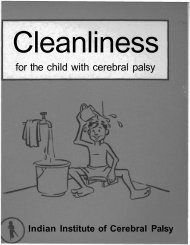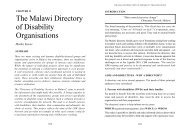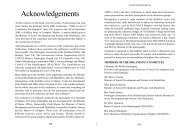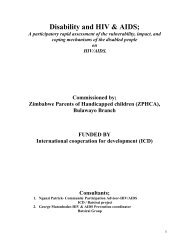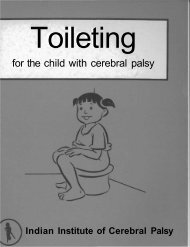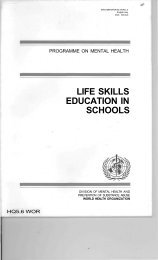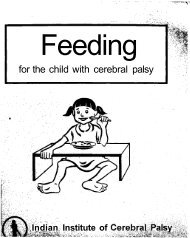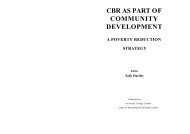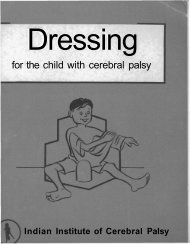Some Controversies in Community Based Rehabilitation - Source
Some Controversies in Community Based Rehabilitation - Source
Some Controversies in Community Based Rehabilitation - Source
Create successful ePaper yourself
Turn your PDF publications into a flip-book with our unique Google optimized e-Paper software.
SOME CONTROVERSIES IN CBR<br />
programmes <strong>in</strong> the eighties and early n<strong>in</strong>eties endorsed this view (Helander,<br />
1999). With the change towards a social model that emphasised equity<br />
and <strong>in</strong>tegration, CBR as it evolved subsequently, began to address the<br />
need to <strong>in</strong>clude all people with disabilities with<strong>in</strong> its ambit of services<br />
and <strong>in</strong>terventions. In reality, however, the desired level of equity has not<br />
been achieved, leav<strong>in</strong>g out some sections of people with disabilities.<br />
It is estimated that about 20% of the disabled population that requires<br />
<strong>in</strong>terventions from a CBR programme are people with severe disabilities,<br />
many of whom would also have multiple disabilities (Rajendra, 2001).<br />
In poorer communities, the percentage of people with severe disabilities<br />
is low, as the families may not seek help for their survival. In some<br />
communities, mortality of children with disabilities reaches almost 80%,<br />
lead<strong>in</strong>g to a ‘weed<strong>in</strong>g out’ phenomenon (Rajendra, 2001). However small<br />
their number may be, CBR programmes face many difficulties <strong>in</strong> deal<strong>in</strong>g<br />
with the impairment aspects of severe disabilities. Many programmes<br />
are <strong>in</strong>itiated by external agents, who need to build a rapport with the<br />
community and show quick results. They often achieve this by work<strong>in</strong>g<br />
with mildly and moderately disabled persons. As a result, people with<br />
severe disabilities tend to be left out of <strong>in</strong>terventions. Most CBR<br />
programmes also do not have personnel who are adequately tra<strong>in</strong>ed to<br />
deal with this group. <strong>Some</strong>times, <strong>in</strong> the process of promot<strong>in</strong>g ‘community<br />
participation’ and ‘rights’ of disabled persons, the impairment needs of<br />
severely disabled persons get neglected. As yet, there are no valid methods<br />
to effectively address the needs of this group at the community level.<br />
Women with disabilities are another group whose needs are not<br />
adequately addressed by CBR programmes, particularly <strong>in</strong> traditional<br />
cultures. Although disability leads to segregation of both men and<br />
women, women with disabilities face certa<strong>in</strong> unique disadvantages, such<br />
as difficulties <strong>in</strong> perform<strong>in</strong>g traditional gender roles, participat<strong>in</strong>g <strong>in</strong><br />
community life, and access<strong>in</strong>g rehabilitation services which are<br />
dom<strong>in</strong>ated by male service providers (Thomas, 2001). Concerns of<br />
women with disabilities also tend to get neglected, <strong>in</strong> organisations of<br />
people with disabilities that are usually dom<strong>in</strong>ated by disabled men. Even<br />
the women’s organisations <strong>in</strong> develop<strong>in</strong>g countries consider these women<br />
21



